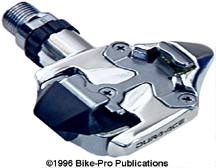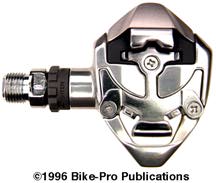


Shimano in the 1993 model year, introduced an ultra lightweight set of SPD Road pedals. The 7410 pedals are single sided with the body made of a single piece of forged aluminum that is high polished then clear anodized. The body has three tapped holes on the top for the steel cleat saddle to bolt to. There are two other tapped bolt holes for the SPD release system itself to bolt to the rear of the body. The saddle piece is larger on this SPD pedal than those on the other 4 SPD mountain pedal sets. This is because Shimano designed a new cleat set, the 70 series cleat, that isn't directly compatible with the MTB pedal sets. Shimano originally had planned to make both their Road and MTB pedals the same, however to give the greater degree of free rotation needed in the Road pedal, both the cleat and pedal were modified so greatly that compatibility wasn't possible. The 7410 and the 6500 pedal sets use one cleat, all the others use the MTB cleat. The interior of the body is tapped with threads for the single unit spindle and bearing assembly to thread into. The spindle and bearing assembly employ the same design as the M737, M525, A525, 6402, and the 1056 pedals, but the entire unit is downsized. The spindle is made of Chrome Cro-moly steel with an overall length of 70mm. The unit uses twelve 2.2mm ball bearings at both ends of the steel roller tube that functions as a double bearing cup. The thread in Grey plastic cartridge fixing nut on this system is both shorter and smaller in diameter the those used in the other pedal sets. The shorter spindle length reduces the unit's overall weight from 96 1/2 grams in the M525 to just 61 1/2 grams in the 7410. The spindle cartridge is user rebuildable. The entire unit can be removed with the included Shimano TL-PD40 tool, then a 7mm and 10mm spanner wrench is used to loosen up the race assembly. The cleat release tension indicator is vertical and like the A525, at the rear of the pedal. Tension is adjusted using a 3mm hex wrench on a bolt at the bottom of the pedal. Shimano chose to make another SPD cleat style to permit rotational freedom in this pedal. The cleats used in 7410 are remarkably similar to the SH-50 and SH-55 sets used in other SPD sets.

For the 7410 pedals, riders must use a SM-SH70, which creates a fixed position for the shoe/foot, or the SM-SH71, which permits cleat rotation of up to 6 degrees in the lateral pedal movement without release. The 70 series cleats, though the same length, are slightly wider than the 50 series cleats, with notches on the upper surface slightly different (see detail shot). Understand that any SPD compatible shoe can be used with these cleats. They have the same mounting style as the 50 series cleats, but Shimano has introduced a new wrinkle in shoes this year. You may remember that SPD gained popularity because the cleat itself was small enough to be fully recessed into the sole.

With the 7410 introduction Shimano has also released a new road racing shoe called the SH-R210 that has a smooth sole on the bottom and doesn't recess the SPD cleat. This smooth sole design permits the SH-R210 to be used with LOOK compatible cleats for the 7401, 6402 and 1056 pedals, or use the 70 series cleats. For those riders who ride then get off and walk on their cycling shoes, the exposed SPD cleat would be scraped up and damaged, and there would be no traction with a smooth hard plastic sole, and raised steel cleat. For this reason Shimano has developed a set of Pon-toons that bolt beneath the 70 series cleats, adding rubber faced traction to both sides of the cleat. These Pon-toons can be used with any smooth-soled, non-recessed SPD compatible shoes. Two sets of Pon-toons are included with each pair of 7410 pedals. The use of Pon-toons is unnecessary if you use the SH- A100, SH-A050, SH-M200, SH-M110, SH-M051, SH-M030, or any SPD compatible recessed-cleat soled shoe. Shimano 7410 pedals come with a pair of each style 70 series cleats. To enter the pedal, the toe of the cleat is inserted first ,then downward pressure pushes the rear locking lever back, which slides over the upper rear of the cleat to hold it firmly. The release is accomplished by rotating the shoe inward to the bicycle, or outward away from it. The weight of a pair of SM-SH71 cleats with mounting hardware is 49 grams. A pair of Pon-toons weighs 21 grams and the pair of 7410 pedals weigh 319.5 grams.


For 1994 Shimano has filled out their Road pedal line by delivering the single sided 6500 pedals. Like the 7410 pedal set, the 6500 set uses the 70 series cleat, and come with a set of fixed position SH70, a set of rotational SH71 cleats, and a pair of the Pon-toons. Each of the cleat types and the Pon-toons are discussed above in the 7410 description. The single piece forged aluminum body is polished and left Silver. The body has three holes tapped holes on the upper surface that the cleat saddle is bolted to. The steel cleat saddle on the 6500 is a modified version of the 7410 saddle, that's slightly larger and therefore slightly heavier.

The 6500 uses the single unit spindle and bearing assembly design of most Shimano pedals. In this case, it's a variation of the one used in the M525, that is 85mm long, with the unit weighing 79 1/2 grams. The spindle unit is user re-buildable. Removal of the unit is accomplished with the included TL-PD40 tool, and again uses a steel roller tube that makes the cups for the two sets of twelve 2.3mm (.0915") ball bearings. The cleat release tension indicator like the A525, and the 7410 is vertical, at the heel of the pedal. The clear rubber covers over the indicator is actually labeled to guide your adjustment. A 3mm hex wrench is used to make adjustments at the pedal bottom. The weight of a pair of SM-SH71 cleats with mounting hardware is 49 grams. A pair of Pon-toons weighs 21 grams and the pair of 6500 pedals weigh exactly 350 grams.